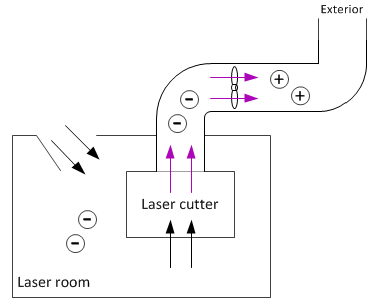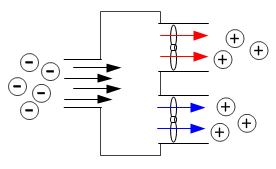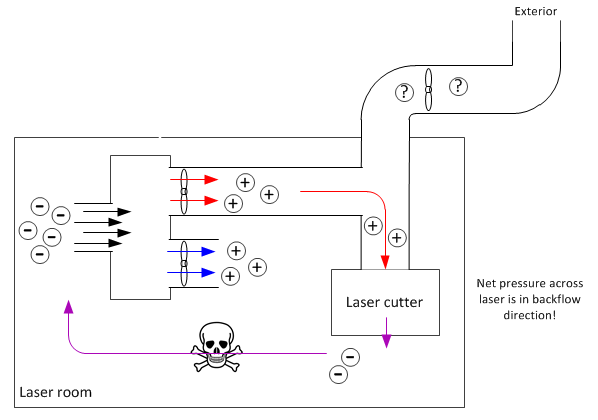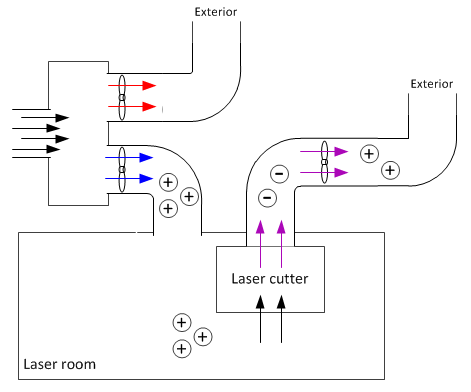Overview
Some quick notes on the laser cutter exhaust and air conditioning.
Existing laser cutter exhaust

Note: The laser cutter does not have its own fume exhaust fans. The fans it has are for cooling the laser only, and are not involved in the flow of air through the cutting chamber. So that laser cutter is entirely dependent on external exhaust duct suction for fume management.
By virtue of suction (negative pressure) at the rear of the laser cutter
chamber, air is drawn in the front of the laser cutter, into the
cutting chamber. It exits through the duct at the rear.
That duct leads up above the shop area where there is an exhaust blower,
much of whose job is to overcome the resistance of the long duct run
from laser to warehouse roof.
The blower is a Hurricane (nominally) 745 CFM 8-inch model. The ductwork is mostly 8-inch, with a vertical section of 6-inch dropping into the laser room, and an initial run of 4-inch flex hose connecting the laser exhaust exit to the 6-inch duct.
Though the blower is rated at 745 CFM, that's a nominal value, greatly reduced by the resistance in the attached ductwork (and any difference in pressure between the ends), which in our case is extraordinarily long. Further, a significant portion of that resistance is in the 6-inch drop and then 4-inch flex duct connecting to the laser. Basically, we get a usable flow through the laser as a result of the negative pressure in the 8inch duct above the ceiling, operating on the the resistance of the 6in-4in run. (Think Ohm's law.)
Epilog says the laser fume extraction airflow requires 400cfm -- basically you need enough to ensure that fumes exit the rear of the laser cutter, without so much airflow that lighter workpieces blow around inside the machine. This we have.
This air flow rate deteriorates if the pressure in the laser room is negative, which happens if the door is closed so air can't enter the room to replace air exiting through the duct. In addition, we don't want to make other changes that increase negative pressure in the room, or reduce the negative pressure in the duct that pulls exhaust from the laser.
Note: To be clear: the term "negative pressure" refers to "less than atmospheric pressure". Also "increase negative pressure" means pressure that's "more negative".
Air conditioner
An air conditioner's air flow looks as follows:

Incoming air divides into two paths: Some air gets cooled and exits as cold air. Other air is used to remove heat from the heat/cold separator, and exits via a separate path as hot air. The intake means suction and negative pressure, and the exits mean positive pressure. In a large or ventilated space, these pressures are negligible. In a small closed space they are not.
Adding air conditioning to laser room
How not to do it:

"Let's put the AC unit in the laser room, exhaust hot air into the laser fume duct, and operate with the door closed to keep the cold air in".
Feeding hot air output from the AC into the laser exhaust duct is in general a bad idea, because AC output flow rate and pressure works against the operation of the existing exhaust duct. The diagram shows the worst case example of this, in which not only does the AC output cause back pressure in the laser exhaust, but also the AC input causes negative pressure in the room. Both these work together to circulate fumes directly out of the front of the laser cutter into the room. Which, with the door closed, has no other ventilation.
A better scenario

This diagram has the AC unit external to the laser room, only blowing cold air into the room. This has the effect of adding pressure to the room, so adds to the effect of the exhaust duct blower to push fumes out the rear of the laser cutter and out through the laser exhaust duct.
The diagram shows the AC hot air vented to the exterior, which could be done by ducting over the hallway to the 14th St wall. Alternatively, just vent to the warehouse interior. It will either mix with the local air, warming it a little. Or, being relatively hot air, it will rise to the top. Displacing some other air, pushing the entire gradient of air temps down, so raising the temps at floor level a bit.
Which adds to the motivation to improve warehouse roof exhaust blower situation.